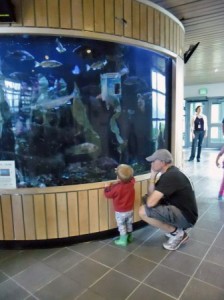
Hundreds of people poured into Juneau’s Ted Stevens Marine Research Institute, or Auke Bay Laboratories, on Friday, a day set aside to honor its namesake and his legacy in Alaska.
The late Ted Stevens served the state in the U.S. Senate for 41 years and left a major mark on fisheries protection laws.
Stevens was killed in a plane crash in 2010 and the next year the Alaska Legislature made every fourth Saturday in July “Ted Stevens Day.”
It was July 27th this year, so the National Oceanic and Atmospheric Administration hosted an open house the day before at the Auke Bay laboratories.
Nine-year-old Blake Plummer is holding a sea anemone.
“It’s really sticky. It’s like squishy and it’s like really clear. If I put my finger on the tentacle, it like sticks a little bit,” she describes.
Blake is one of a lot of children visiting the Ted Steven’s Marine Research Institute on Friday. Daily tours at the lab are usually for ages 16 and up.

The kids and parents hover over the touch tank. Inside are inter-tidal organisms like sea stars, urchins, sea cucumbers, and hermit crabs.
Lucky for them it happens to be a special day.
This is the first time the Ted Stevens Marine Research Institute has held an open house to celebrate Ted Stevens Day.
The 69-thousand square foot facility opened in May 2007 and cost $51 million.
Director Phil Mundy says naming the facility after the senator was obvious.
“Ted Stevens was responsible for a lot of the legislation that’s protected our fisheries and brought the fishing industry into our ports and onto our shores. We just wouldn’t have any sort of fisheries nowadays without the efforts that Ted Stevens put in when he entered the Senate in 1968,” Mundy said.
Congress passed the Magnuson-Stevens Fishery Conservation and Management Act in 1976. It’s the primary law governing marine fisheries in the United States.
“Senator Stevens really had vision and also he had tenacity. He could really get in there and slug it out for what he wanted, so he not only got the Fishery Conservation and Management Act passed, he also developed this over a period of nearly 30 years into the legislation that it is today,” Mundy says.
Wyatt Fournier is a NOAA fisheries biologist at the Auke Bay labs. On this day, he’s also a tour guide. He guides a group to the necropsy lab.
“So if we find a marine mammal that’s washed up on shore and we don’t know how it died, this is the only place in Juneau you can bring it,” Fournier explains.
NOAA public affairs officer Julie Speegle says the Ted Stevens Day open house brought a lot of people to the research institute, including the late Senator Stevens’ wife, Catherine Ann Stevens.
“She took the tour, looked around at things, and really liked what she saw. She also took the time to speak to the employees here and told them how she’s very interested in their work and really supports what we do here,” Speegle said.
Research taking place at the labs on the status of fish stocks, fish habitats, and marine ecosystems helps develop policy for fishery management.
Cara Rodgveller works in the marine ecology and stock assessment program. She says she loves watching how excited the children get at the touch tank.
“‘Cause I remember being like that when I was little and seeing fish, and growing up fishing, and that’s why we got into this business,” she explains.
Blake Plummer contemplates her favorite thing in the touch tank, “Uh, probably that sea cucumber.”
Who knows, perhaps one day Blake will be working at the Ted Stevens Marine Research Institute.
Lisa Phu is a reporter at KTOO in Juneau.




